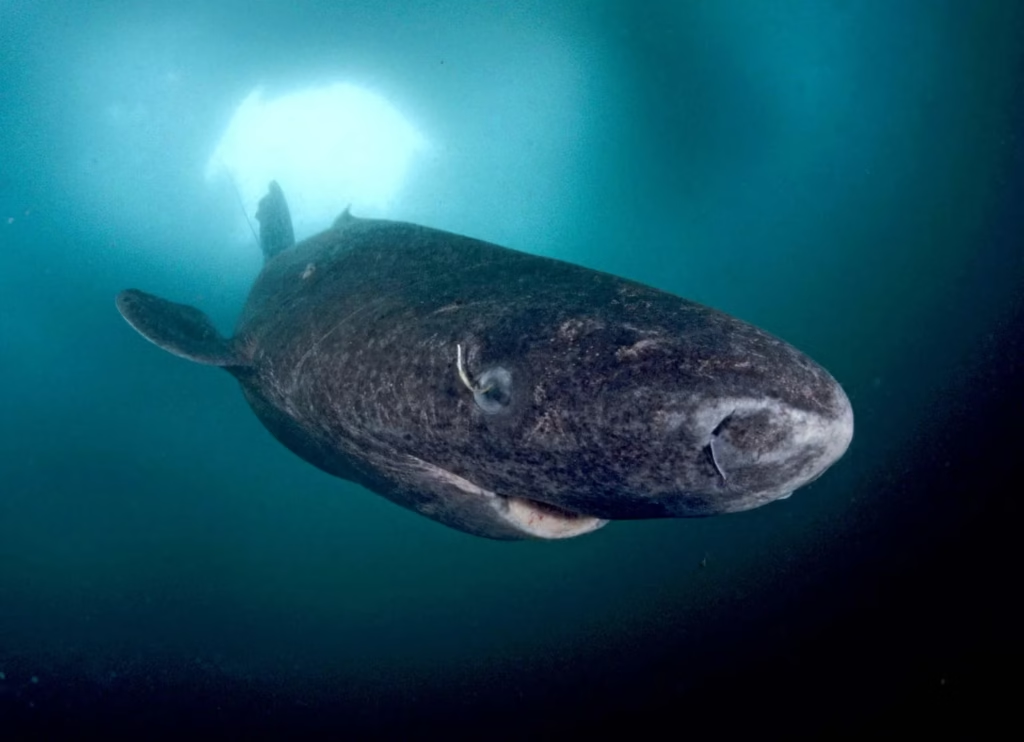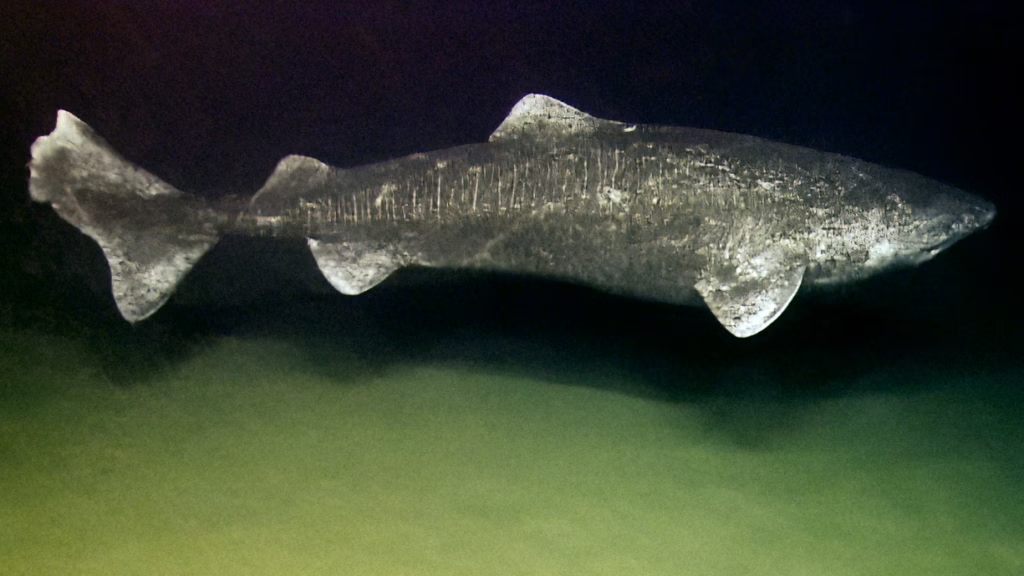
If you thought a sea creature living a few decades was impressive — think again. The Greenland shark holds one of nature’s most astonishing records: it may live for hundreds of years. That’s right — not decades, but centuries. In this blog post we’ll dive into the incredible life of the Greenland shark: how it lives, where it lives, what makes it so special, and why it matters.
To explore all of these processes in 3D, check out our detailed YouTube explanation linked at the end of this blog — and don’t forget to subscribe for more insightful videos! (Available in English & Malayalam )

Love what I do?
Consider supporting my work by👉 buying me a coffee
What is the Greenland Shark?
The Greenland shark (scientific name Somniosus microcephalus) is a large, slow-moving shark species that lives in the icy, deep waters of the North Atlantic and Arctic Oceans.
Here are the key facts:
It belongs to the “sleeper shark” family (Somniosidae), so called because of their sluggish, slow-moving behaviour.
It’s among the largest shark species alive today, reaching lengths of up to about 6.4 m (≈21 ft) or more in some reports.
It lives in extremely cold water — often just above freezing — and can inhabit depths of hundreds to over a thousand metres.
Because it lives in harsh, remote conditions, it is still one of the less-studied shark species, adding to its mystery.
In short: it’s a big, mysterious, slow-moving shark that thrives in some of the coldest, darkest parts of the ocean.
How Long Can It Live? The Astonishing Lifespan!

One of the most remarkable things about the Greenland shark is its longevity. Scientists believe it lives far longer than any other known vertebrate animal. Some of the key points:
The largest studied sharks may be at least 272 years old, and possibly up to 500 years old.
This lifespan makes it the longest-living vertebrate known.
Some individuals alive today might have been swimming when Shakespeare was penning his plays or when sailing ships first crossed oceans in the age of exploration.
Why are the numbers so wide?
The methods for aging sharks like this are indirect. Unlike some fish that have clear growth rings, the Greenland shark’s vertebrae are soft and don’t carry the typical age rings. Scientists instead use proteins in its eye lens to estimate age.
Radiocarbon dating has inherent uncertainty, especially in deep-sea conditions, which contributes to the wide lifespan range.
Its slow growth also means age-for-size relationships are less direct and harder to calibrate.
Sexual Maturity and Growth Rate
Greenland sharks grow extremely slowly — less than about 1 cm per year in many cases.
They may not reach sexual maturity until around 100 to 150 years old.
This combination of traits contributes to their extraordinarily long lifespan.
What Makes Greenland Sharks Live So Long?
You might wonder: Why does the Greenland shark live for centuries? The answer lies in several key factors:
Cold, Deep-Water Lifestyle
Living in very cold water slows metabolic processes, reducing cellular damage over time.
The shark inhabits depths and temperatures where life moves slowly — fewer predators, slower growth, and less frequent reproduction.
Its metabolic enzyme activity does not decline significantly with age, which may help it avoid many aging-related problems.
Slow Growth & Delayed Maturity
Growing slowly means fewer cellular divisions and less cumulative damage.
Delayed reproduction allows the shark to invest energy in longevity rather than early reproduction.
Low Predation and Stable Environment
Fewer predators in deep Arctic waters mean less risk of external mortality.
A stable, cold environment favors long-lived species.
Special Cold-Water Adaptations
The Greenland shark has high concentrations of urea and trimethylamine N-oxide (TMAO) in its tissues, which help protect cells in freezing water.
Its low activity level and slow swimming speed reduce energy expenditure, contributing to its long life.
Size, Appearance, and Behavior
Appearance
The Greenland shark has a stout, cylindrical body, a short rounded snout, and small eyes.
Its coloration is typically gray to brown, sometimes with lighter spots or bands.
Size and Growth
Typical lengths are 8 to 14 feet, with maximum sizes reaching 21 feet or more.
Growth is extremely slow; one shark studied grew only about 6 cm in 16 years.
Habitat & Depth
Found in the North Atlantic and Arctic Oceans, it tolerates Arctic conditions year-round.
Depths range from 100 to 1,200 meters or more, with water temperatures near freezing.
Diet and Feeding
The Greenland shark is an opportunistic predator and scavenger, eating fish, skates, wolffish, seals, and occasionally larger prey like reindeer or moose carcasses.
Its slow swimming speed means scavenging plays a major role in its diet.
It is affected by a parasitic copepod on its eyes, which can damage the cornea and reduce vision, making it rely more on smell than sight.
Reproduction, Life Cycle, and Vulnerabilities
Reproduction
Greenland sharks are ovoviviparous: eggs are fertilized internally and pups are born alive.
Females may carry up to 10 pups at a time.
Gestation periods may be exceptionally long, possibly 8–18 years or more.
Sharks reach sexual maturity very late, around 100–150 years of age.
Vulnerabilities
Because of slow growth and late reproduction, Greenland sharks are highly vulnerable to human impacts.
Bycatch in fishing gear can remove mature individuals, reducing reproductive output for decades.
Historical hunting for liver oil and environmental changes also threaten their populations.
The species is listed as vulnerable due to its slow life history and susceptibility to human activity.
Why the Greenland Shark Captures Our Imagination
The Greenland shark is fascinating for several reasons:
Longest-living vertebrate: Lifespans of up to 500 years make it extraordinary.
“Time machine” of the deep: Some sharks alive today may have been swimming in the 1500s or 1600s.
Extremophile lifestyle: Thriving in freezing, deep water, scavenging for survival, and moving slowly makes it a mysterious predator.
Science implications: Its longevity may reveal secrets about metabolism, aging, and physiology.
Conservation symbol: Its slow life cycle reminds us that human impacts, even small ones, can threaten long-lived species.
Important Takeaways
Greenland sharks live for hundreds of years, perhaps up to 500 years.
They grow very slowly, live in freezing deep water, and reproduce very late.
Their biology makes them vulnerable to human impacts.
Understanding them can provide insight into aging, longevity, and marine ecosystems.
The Bigger Picture
The Greenland shark exemplifies nature’s extremes — slow, enduring, and patient.
Time scales: Its life challenges our human-centric view of time.
Adaptation: Slow growth, low metabolism, and deep-sea living demonstrate survival under extreme conditions.
Conservation lessons: Long-lived species require careful management, as human activity can have lasting impacts.
Scientific inspiration: Its longevity may offer insights into biology, aging, and adaptation.
Conclusion
The Greenland shark is not just another fish — it is a living monument of the deep sea. A creature that glides silently through centuries of history, unseen by most, and yet enduring while generations of humans come and go.
Its story reminds us that life can thrive in the slow lane, that oceans hold mysteries far older than we realize, and that some species require our care to survive. From its freezing habitat to its astonishing lifespan, the Greenland shark is a testament to the resilience and wonder of life on Earth.
Next time you think of sharks, remember this: the Greenland shark is a living time machine, slowly cruising the Arctic depths for centuries, a silent witness to history itself.
FAQs
Q: Can Greenland sharks harm humans?
A: Very rarely. Their deep, slow-moving lifestyle keeps them mostly away from people.
Q: Can humans eat Greenland shark?
A: Raw flesh is toxic due to compounds like TMAO. In Iceland, it is processed through fermentation to make it edible as hákarl.
Q: Could a Greenland shark really have been alive when Shakespeare wrote his plays?
A: Yes. Some individuals may be 300–400 years old, making it plausible.
Q: What threatens Greenland sharks today?
A: Bycatch, historical hunting, and climate change are the main threats. Recovery is slow due to late maturity.
Want to learn more through visual storytelling? Check out our detailed 3D explanation blog on Are Zombies Real? Myth and Science
Useful Links – Greenland Shark